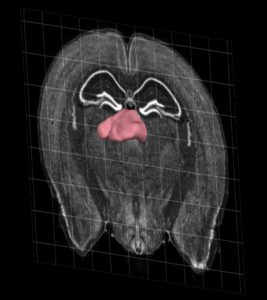by Mike Wallace
Neuroscientists have had a long-standing interest in midbrain dopamine neurons, mainly due to their critical function in reward and reinforcement learning. However, a brain region directly upstream of dopamine neurons has recently piqued the interest of those focused on identifying the genesis of major depressive disorder. Known as the habenula, this region is important for associating recently performed actions with negative (bad) outcomes.

A coronal section of the mouse brain highlighting the location of the habenula (red). Image courtesy of the Allen Brain Institute
The habenula receives direct input from a highly diverse set of brain regions (basal ganglia, hypothalamus, frontal cortex, etc.). It targets not only dopamine neurons, but serotonergic neurons as well—serotonin being another neuromodulator that is important for emotional control and targeted by antidepressants. This leaves the habenula positioned to modulate both motivation and mood control.
Mike Wallace, Kee Wui Huang, Dan Hochbaum, Minsuk Hyun, and Gianna Radeljic in Bernardo Sabatini’s lab hypothesized that different genetically-defined populations of neurons in the habenula differentially targeted these distinct brain regions. Using single-cell sequencing techniques, they profiled the genetic diversity of the neurons of the habenula. They found several genetically distinct populations of neurons, and were able to show that these distinct neuron-types targeted different classes of neurons in dopaminergic and serotinergic regions of the brain. These findings suggest that the habenula contains distinct sub-circuits that control two neuromodulatory centers important for mood, motivation, and depression.
Mike Wallace is a Research Fellow in the lab of Bernardo Sabatini at Harvard Medical School.
This story will also appear in the HMS Neurobiology Department newsletter, The Action Potential.
Learn more in the original research article:
Anatomical and single-cell transcriptional profiling of the murine habenular complex.
Wallace ML, Huang KW, Hochbaum D, Hyun M, Radeljic G, Sabatini BL.
Elife. 2020 Feb 11.
News Types: Community Stories
